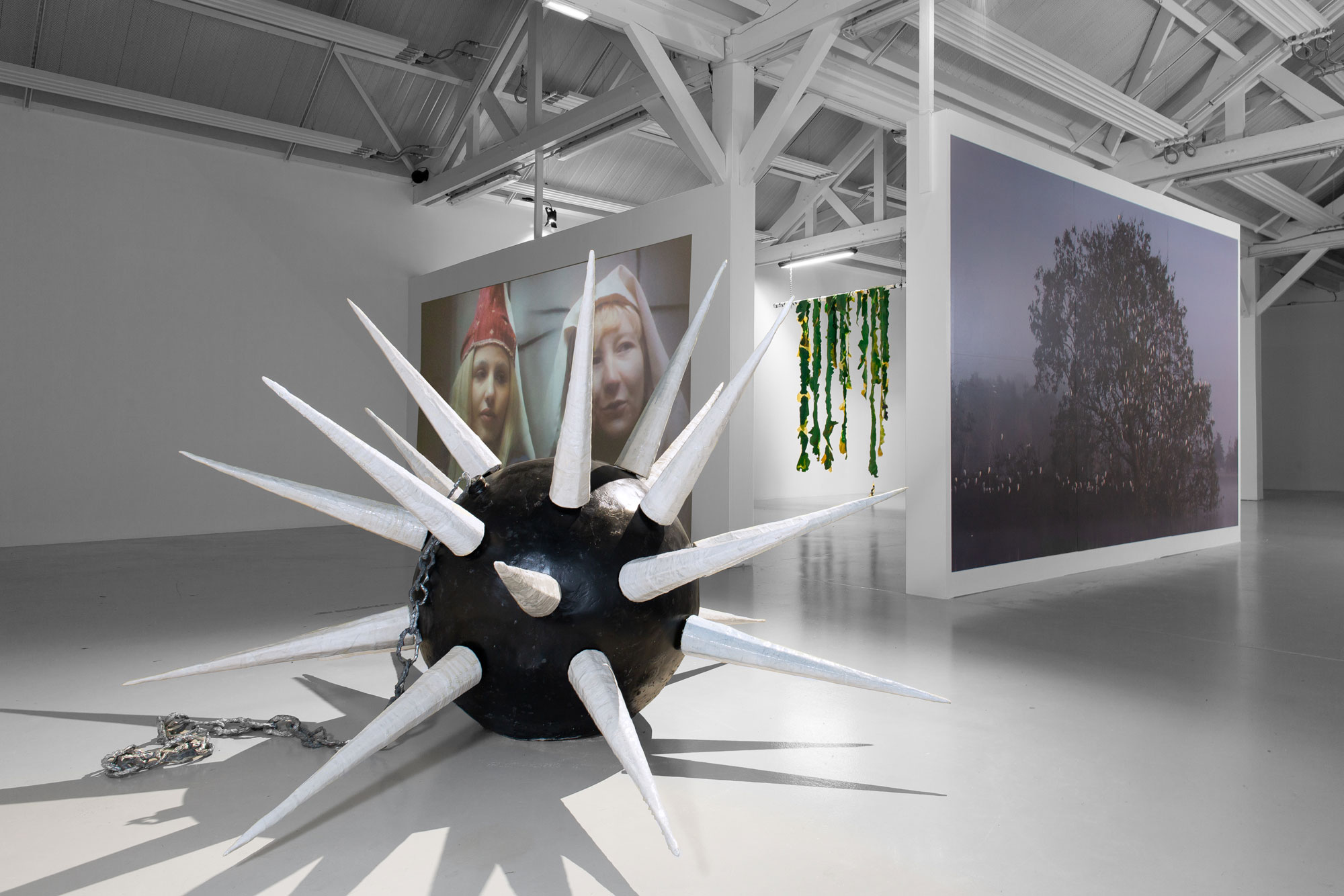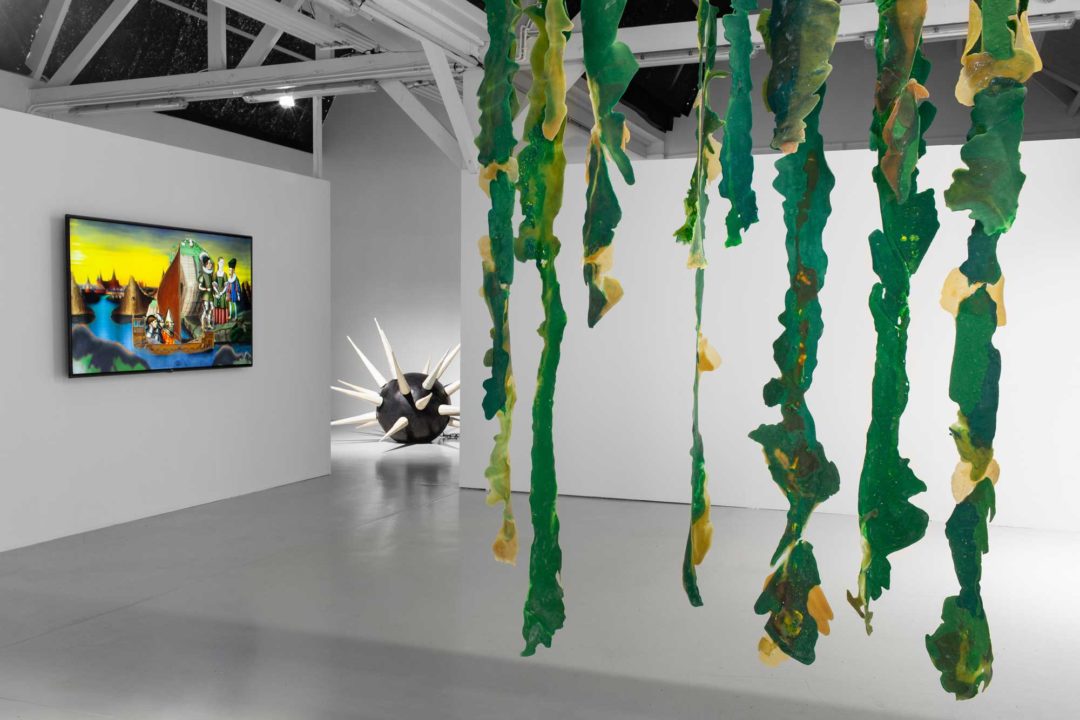Stanislas Paruzel at 40mcube

Stanislas Paruzel, “Non Complete Story”
40mcube, Rennes
14.10.2023 – 23.12.2023
A landscape, perhaps marshy, shot in large format, shrouded in a mist, possibly morning or winter. A tree stands out, punctuated by small white spots, probably egrets. In this first contact with Stanislas Paruzel’s exhibition Non Complete Story at 40mcube, nothing is certain. The photograph seems to have been manipulated. It is pixelated and blurred at the same time, vaguely familiar but almost disturbing in its quirks. As the exhibition title suggests, the story of this first image is partial or imperfect. It is an effective foreword to the works presented in the exhibition, which give us access, in dissociated fragments, to the Tristan and Iseult’s legend.

Disregarding the chronological order of the traditional narrative, this adaptation of the mediaeval tale was initiated in 2021 at an exhibition at the Pernod Ricard Foundation, with the video production of Chapter VI, The Attack of the Irish dragon. Then, in 2021-2022, as part of his GENERATOR training, the artist produced Chapter XV, Marc perched in the tall pine tree. For this first solo exhibition, he continues with Chapters I and II, Tristan’s childhoods. Stanislas Paruzel’s ambition with this long-term project is to transpose all the chapters of the novel to the screen, using different and specific video techniques each time. At this stage, therefore, he is assuming a double incompleteness, first by giving us snippets of an artistic adventure in the making and then by creating a system of images that are deliberately unfinished and mismatched.
In a nod to early cinematic experimentation and its crude special effects, he cobbled together his own tools and sets, using very few resources. He called on friends to play the characters in the episodes. They all changed each time, with only Tristan being played by the same person. With the help of his mom, he makes mediaeval costumes that are fairly basic and mixed with very contemporary details. The props are low-tech, made from poor materials such as plaster, wood, cardboard, polystyrene, and wax. Digitally, it’s a hybrid of live action, actor direction, 3D animation and modelling, green screen inlay, and perhaps soon puppets. Each chapter has a very specific visual identity. In Chapter XV, flesh-and-blood actors move between a green background and a hand-crafted set around a fountain made of wood, cardboard, plaster, fimo clay, and resin. In Chapters I and II, animation and artificial intelligence take us on a journey through the pages of an old manuscript.
With a resolutely Do It Yourself aesthetic, he doesn’t hesitate to break the fourth wall by revealing the inner workings of the film: in Chapter VI, we see both the boom operator and the storyboard for the extract itself, trapping the narrative with the disturbing effects of mise en abyme. The objects created for the filming become independent of the videos, playing with scale and becoming exhibited sculptures: here, the flail weapon used in the battle with the dragon, greatly enlarged and made from plaster, cardboard, and resin. There, the 3D-generated pine branches are given a plastic counterpart in Banjo Killer #2, a sort of shred of coloured latex. Like the alternating zooms in and out of the camera, the sculptures impose on us the same disordered relationship of proportions between an anthropomorphic moon that has become massive, and miniaturised worlds that mix pineapple skins, fishing lures, and dog toys (Banjo Killer #1).
It’s all a bit clunky, and the outlines, however dented or hallucinated, are dreamlike and chivalrous, blending in turn the aesthetic legacies of Mannerist, Expressionist, and fantasy cinema. In a sort of intimate digest of Stanislas Paruzel’s work, we find a jumble of irregular compositions, temporal and spatial distortions, sudden camera movements and unusual angles, saturated colours and light, and disturbing depths of shadow. We oscillate between the supernatural and the grotesque, surrounded by a monstrous bestiary of dragons, animated marginalia, a moon owl, a huge fly, a frog playing chess… The already marvellous content of the legendary tale is accentuated by all these tricks, creating imaginary vignettes stripped of all grandiloquence.

Without restricting his corpus to the seventh art, Stanislas Paruzel draws on references from pop-culture: the video game The Legend of Zelda, from which he borrows the character of the moon that appears in the episode Majora’s Mask, then crossed with that of Georges Méliès; the hilarious humour of Monthy Python and their parodic quest for the Grail, from which the character who interrupts a conversion to share his search for sticks in Attack of the Irish Dragon could have come. He also nourrishes his work with an expansive collection of iconography and text, from painting, comics, video games, and literature, as well as more academic sources such as Michel Pastoureau’s historiography of colour. This referential syncretism has the dual effect of dusting off the Middle Ages, delivering an emancipated version of it, to use the terminology of Clovis Maillet and Thomas Golsenne, very precisely documented, but interpreted with fantasy and freedom; but also, through this premodern and mediaeval flashback, of taking a critical step back on the construction of images by digital means and the perverse tyranny of storytelling, recently analysed by Christian Salmon for AOC. Thus, with humour and anomaly, the narration of the episode of Marc perched in the great pine tree seems to be provided by a fly in the reflection of his exorbitant eyes.
He worked from the modern Tristan et Iseult’s French version, compiled and written by Joseph Bédier and René Louis. The successive transpositions, first from oral to written, then with Non Complete Story, from written to visual, naturally suggest the many errors, additions, and transformations of the original legend. Like these translation discrepancies, the final chapters, produced using AI, are riddled with anomalies, from mutant fingers to oddly tilted faces, the manipulation of images materialising on screen the manipulation that has been carried out for centuries on our supposedly founding stories, to the benefit of dominant positions and discourses, of love patterns conditioned by hetero-patriarchy in the case of Tristan and Isolde, for example.
After wandering through the exhibition from sculpture to sculpture and watching the three films, if you close your eyes, you can hear a confused hubbub: the slightly old-fashioned voice of a narrator, the crash of combat, the flow of water, sung onomatopoeia, and slimy echoes. Perhaps this is our historical rumour, our composite heritage, an almost white tumultuous noise.
1 All the notes and signs written in the margins of a text on a manuscript, ranging from annotations and commentaries to jokes and satirical creatures.
2 La tyrannie de l’Histoire et Contre l’absolutisme narratif, 28 et 29 novembre 2023, AOC.
______________________________________________________________________________
Head image : Stanislas Paruzel, Non Complete Story, 2023, vue de l’exposition. Commissariat : 40mcube et Stanislas Paruzel. Production : 40mcube. (Au premier plan) Fléau d’arme, 2023, plâtre, carton, résine, 140 × 240 × 240 cm. Production : 40mcube. (Au second plan à gauche) Marc juché dans le grand pin (Chap. XV), 2022, vidéo UHD, 18’50’’. Production : GENERATOR – 40mcube / Self Signal. (À droite) L’île aux aigrettes, 2023, impression numérique sur dos bleu, 225 × 400 cm. Production : 40mcube. Photo : Margot Montigny.
- From the issue: 107
- Share: ,
- By the same author: Moffat Takadiwa, EuroFabrique In Romania, June Crespo, Mathilde Rosier et Ana Vaz at CRAC Altkirch,
Related articles
Streaming from our eyes
by Gabriela Anco
Don’t Take It Too Seriously
by Patrice Joly
Déborah Bron & Camille Sevez
by Gabriela Anco

